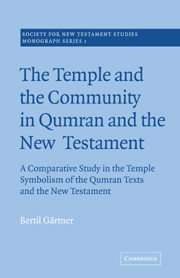 The Temple and the Community in Qumran and the New Testament
The Temple and the Community in Qumran and the New Testament Book contents
- Frontmatter
- Contents
- List of Abbreviations
- Introduction
- AUTHOR'S NOTE
- I The Priesthood and the Jerusalem Temple
- II The Temple Priests and Qumran
- III The ‘New Temple’ in Qumran
- IV Temple Symbolism in the New Testament
- V Temple Symbolism and Christology, Collective and Individual
- Bibliography
- Index of Authors
- Index of Subjects
- Index of Passages Quoted
IV - Temple Symbolism in the New Testament
Published online by Cambridge University Press: 26 February 2010
- Frontmatter
- Contents
- List of Abbreviations
- Introduction
- AUTHOR'S NOTE
- I The Priesthood and the Jerusalem Temple
- II The Temple Priests and Qumran
- III The ‘New Temple’ in Qumran
- IV Temple Symbolism in the New Testament
- V Temple Symbolism and Christology, Collective and Individual
- Bibliography
- Index of Authors
- Index of Subjects
- Index of Passages Quoted
Summary
WE have seen that the Qumran texts contain a consistent temple symbolism, in which the community is represented as the new temple, and in which the true sacrifice is seen as being spiritual in character, offered in the holy and pure lives, the praise and the prayer of the members of the community. No direct parallel to this temple symbolism has been traced in Judaism. There are ‘spiritualized’ interpretations of the temple and its sacrifices in the work of such authors as Philo and Josephus, but there is nothing corresponding to the Qumran community's identification of a group of men with the true temple. And although both Philo and Josephus are to some extent critical of a too realistic attitude to the presence of God in the temple and his approval of blood sacrifice, their work shows no trace of the characteristic Qumran criticism, based on the Messianic self-consciousness of the community that God is in the midst of the ‘true Israel’ (the community) although the Jerusalem temple is defiled.
A number of these themes are of course found elsewhere. For instance, we may compare the concept of the ‘remnant’, which contains a number of similar ideas. The Old Testament and late Judaism speak of the ‘remnant’ as the company of those who are to be saved in the last days. There was discussion, particularly in late Judaism, as to whether this ‘remnant’ was identical with the whole of Israel, or whether it was only a group within the nation.
- Type
- Chapter
- Information
- The Temple and the Community in Qumran and the New TestamentA Comparative Study in the Temple Symbolism of the Qumran Texts and the New Testament, pp. 47 - 122Publisher: Cambridge University PressPrint publication year: 1965


